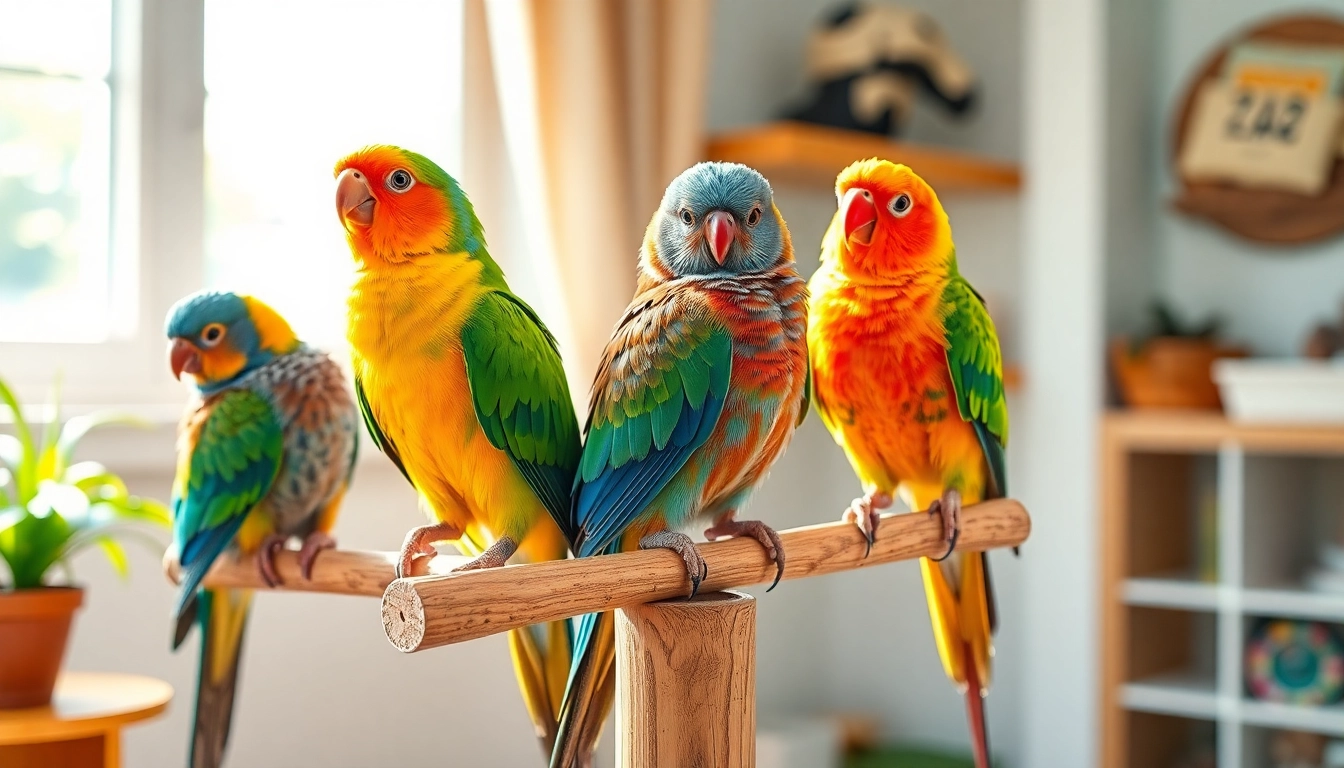Top Tips for Caring for Pet Birds: A Guide to Happy, Healthy Companions

Introduction to Pet Birds: Choosing the Right Species
Bringing a pet bird into your home can be an incredibly rewarding experience, offering companionship, entertainment, and a touch of nature’s beauty. However, selecting the right species is essential to ensure a harmonious relationship and a healthy lifestyle for your new feathered friend. Each bird species varies greatly in terms of size, lifespan, temperament, care requirements, and activity levels. Understanding these differences helps prospective owners make informed decisions aligned with their lifestyle, household environment, and personal preferences.
For those interested in exploring the world of avian companionship, it’s important to start by familiarizing yourself with various types of pet birds. From the lively and colorful parakeets to the majestic Macaws, every species offers unique qualities and care challenges. This comprehensive guide aims to provide an in-depth overview of the most popular pet bird species, essential considerations in selecting and caring for your bird, and practical tips to ensure your avian companion thrives for years to come.
Understanding Different Types of Pet Birds
Popular Bird Species and Their Characteristics
The landscape of pet birds ranges from small songbirds to large, intelligent parrots. Each has its own behavior, care needs, and social tendencies. Below, we explore some of the top contenders for best pet birds, drawing insights from expert sources and pet owner experiences.
- Budgerigars (Budgies or Parakeets): Small, vibrant, and highly social, budgerigars are among the most popular pet birds worldwide. With an average lifespan of 5 to 10 years, they are well-suited for beginners due to their manageable size and ease of care. Budgies are known for their playful nature and ability to mimic sounds, making them delightful companions.
- Cockatiels: Known for their gentle disposition and expressive crests, cockatiels are another favorite among pet owners. They typically live 15-20 years and require social interaction and mental stimulation. Their affectionate nature makes them ideal for families.
- Lovebirds: These small parrots form strong bonds with their owners and are known for their loyal, affectionate behavior. Lovebirds are social and thrive on interaction but can be territorial if not properly socialized.
- Canaries: Celebrated for their melodious singing, canaries are mostly kept for their vocal talent rather than companionship, though many owners do form strong bonds with them. They are relatively low-maintenance and can live up to 10-15 years.
- Macaws (Hyacinth Macaws, Scarlet, and Blue & Gold): These large, intelligent, and visually stunning birds are known for their long lifespan, often exceeding 50 years, making them a long-term commitment. They require ample space and mental engagement but reward owners with their charismatic personalities and striking aesthetics.
Assessing Your Lifestyle and Bird Needs
Before choosing a bird, evaluate your living environment and daily routine. Consider factors like available space, time for social interaction, and your ability to provide specialized care. For instance, large parrots like macaws demand significant attention, mental stimulation, and spacious cages, making them ideal for dedicated hobbyists or those with plenty of time and resources.
Conversely, smaller species such as finches or canaries may be suitable for apartments or homes with limited space, requiring less interaction but still necessitating proper care and a safe environment. Remember, owning a bird is a long-term commitment—some species can live for decades—and understanding your capacity to provide consistent care is vital.
Common Pet Bird Species for Beginners
For first-time bird owners, choosing species with manageable care routines and friendly temperaments can make the transition smoother. Among these are:
- Budgerigars: Easy to care for, adaptable, and inexpensive, they are excellent beginner birds.
- Zebra Finches: Hardy, social, and relatively simple to care for, finches are ideal for small spaces.
- Cockatiels: Slightly larger but still manageable, with affectionate behaviors suitable for new owners.
- Lovebirds: Small, active, and entertaining, they provide lively companionship when socialized properly.
Essential Care and Maintenance for Pet Birds
Proper Nutrition and Feeding Habits
A balanced diet forms the foundation of good health for your pet bird. Most species thrive on a combination of formulated pellets, fresh fruits and vegetables, and occasional seeds. Pellets are designed to meet the nutritional needs of birds and should constitute the primary component of their diet.
Fresh produce, like leafy greens, carrots, apples, and berries, provides essential vitamins and enrichment. Avoid avocado, chocolate, caffeine, alcohol, and processed foods as they are toxic to birds. Additionally, provide clean, fresh water daily to prevent dehydration and support overall well-being.
Creating a Stimulating Environment
Birds are intelligent creatures that require mental and physical stimulation to prevent boredom and behavioral issues. A well-designed cage should include perches of varied textures and sizes, toys for chewing and foraging, and space to move freely. Rotate toys regularly and incorporate puzzles or foraging devices that encourage natural behaviors.
Allow supervised out-of-cage time to promote exercise, socialization, and enrichment. For example, some owners set up safe play areas or provide foraging opportunities around their homes to mimic natural exploration.
Health Monitoring and Regular Checkups
Early detection of health problems is crucial for long-term care. Observe your bird daily for signs of illness, such as changes in droppings, feather quality, appetite, or activity levels. Regular veterinary checkups specializing in avian medicine should be scheduled, typically annually, to assess overall health and prevent disease.
Maintain cleanliness by cleaning cages, perches, and food dishes regularly. Vaccinations and parasite control may be necessary depending on regional risks.
Training and Socializing Your Pet Birds
Building Trust and Interaction
Establishing a trusting relationship is essential for a well-behaved and emotionally healthy bird. Approach your bird calmly and consistently, using gentle speech and touch. Spend time near the cage, offering treats and talking softly to build familiarity.
Handling should be gentle and patient. For species like parrots, starting with short, positive interactions lays the foundation for more complex training and socialization.
Teaching Basic Commands and Enrichment
Training can include teaching birds to step onto your hand, come when called, or perform simple tricks. Use positive reinforcement with treats and praise to encourage desired behaviors. Enrichment exercises such as puzzle feeders or target training boost mental stimulation and reduce destructive behaviors.
Managing Behavioral Challenges
Common issues include biting, feather plucking, and excessive noise. These problems often stem from boredom, stress, or lack of socialization. Addressing the root cause involves increasing social interactions, enriching the environment, and ensuring proper health care. Consulting with avian behavior specialists can provide tailored strategies to resolve persistent issues.
Long-Term Commitment: Lifespan and Responsibility
Understanding the Longevity of Pet Birds
Many pet birds have impressive lifespans, with some species living 20, 30, or even over 50 years. For example, parrots such as the Hyacinth Macaw can reach 50-60 years in captivity, while budgerigars typically live around 8-15 years.
This extended lifespan implies a substantial long-term commitment that includes ongoing care, diet, social interaction, and health monitoring. Prospective owners should evaluate their personal circumstances and readiness to care for a bird throughout its life.
Preparing for the Future of Your Bird
Successful long-term ownership plans include setting up a proper living environment, obtaining pet insurance, and establishing a care plan for when you are away or unable to care for your bird temporarily. Additionally, consider estate planning or guardianship arrangements to ensure your bird’s well-being if unforeseen circumstances arise.
Community Resources and Support
Many local avian veterinarians, rescue organizations, and bird clubs offer valuable resources, educational materials, and social networks. Joining such groups enables owners to share experiences, troubleshoot challenges, and access expert advice, thereby enhancing both the owner’s and bird’s quality of life.
Frequently Asked Questions About Pet Birds
Are Pet Birds Difficult to Care For?
While birds require dedicated care, attention, and a clean environment, they are not inherently difficult if owners understand their species-specific needs. Successful bird ownership involves regular feeding, social interaction, environmental enrichment, and health monitoring. Some species are more demanding than others, so beginners should start with low-maintenance species like finches or budgerigars.
What Are the Cheapest and Low-Maintenance Birds?
Budget-friendly and easy-care birds include parakeets, finches, and canaries. These species have lower initial costs, simpler housing needs, and shorter training requirements. They are excellent choices for those new to bird ownership or with limited budgets.
Can Pet Birds Live Alone, and Which Species Are Best for Solo Living?
Some birds are naturally more independent and can thrive when kept alone, such as Poicephalus parrots and certain finches. These birds can self-entertain, making them suitable for owners with busy schedules. However, all birds benefit from social interaction and mental stimulation, so consider species that align with your availability to engage with them regularly.
